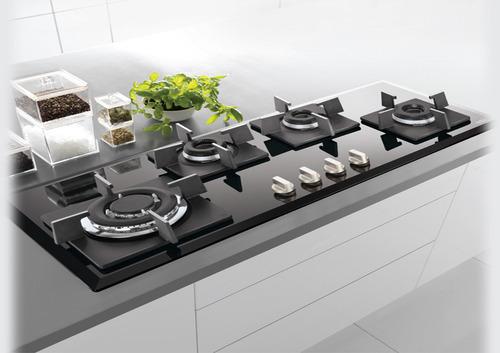News

Guide to Choosing The Best Hob for Your Kitchen
With so many different hobs available online, it can be difficult to know where to start. This guide offers a simple explanation of the main types of hob, and the advantages and disadvantages of each. That way, you’ll be able to focus your search on exactly what you need.
TYPES OF HOBS
There are three popular types of hobs — gas, induction and ceramic.
Gas Hobs
A gas hob uses burners with visible flames, characterised by metal pan supports on top. They’re a traditional choice which is still popular today, and tend to be the first choice for chefs in professional kitchens.
Most of us are familiar with this type of hob in the kitchen. When the gas hob is turned on, a flame lights the gas flowing out of the burners on the cooktop, producing the fire to cook with. You can either use it with gas supplied in liquefied petroleum gas (LPG) cylinders that would have to be replaced when the gas is used up, or piped gas for convenience. As such, determine what type of gas you are using in your home, to select a compatible hob.
ADVANTAGES
- Instant, powerful heat
- Complete flexibility – no set temperature intervals
- Easy to use
- Can be used with any type of cookware
DISADVANTAGES
- Requires a gas supply, so not suitable for all homes
- Can be difficult to clean due to their burners and pan supports
- Less efficient than induction models
Induction Hobs
Induction hobs are unique in the way they heat your pans. They create a magnetic field between the induction element and the base of your cookware, heating your pan directly, rather than wasting energy heating the cooking surface. Aside from a little residual heat, the surface stays relatively cool.
Induction hobs use electromagnetism (generating electricity using magnetism) to create heat inside the cooking pan, rather than from the outside. In a way, it turns cooking pans into cookers, cooking food more directly and quickly, with less energy.
Induction hobs feature touch-sensitive buttons, and different heat settings and programmes for precision cooking, apart from safety features. They come in a variety of sizes and designs, from a portable single-burner to built-in models with multiple burners. There are some models in the market that are exceptionally versatile, such as the Brandt Maxizone and Electrolux Infinite Pure Zoneless (pictured above) induction hobs. With their flexible cooking zones, you can use cookware of almost all shapes and sizes, instead of being confined to specific heat zones.
ADVANTAGES
- Really quick to heat up
- Efficient since no energy is wasted heating the cooking surface
- Stylish designs available
DISADVANTAGES
- Restricted to which pans you can use – cast iron or steel cookware is ideal, but aluminium or copper pans won’t work unless the base has an additional layer which a magnet will stick to
Ceramic Hobs
The phrase ‘ceramic hob’ simply refers to its sleek ceramic glass finish. That means technically, gas on glass and induction hobs are also ceramic hobs. However, most of the time, if a product is advertised as a ‘ceramic hob’, it will be electric, and there are a number of different ways it could work.
Ceramic hobs look similar to induction hobs, but the key difference between them is that ceramic hobs makes use of an element underneath the cooker’s surface, which heats up and transfers the heat to the cooking pan. As such, the surface of the hob will be hot.
ADVANTAGES
- Sleek finish for a premium feel
- Frameless designs are available for an impression of fluidity between your worktops and hob
DISADVANTAGES
- Often more expensive than electric plate or gas hobs
- With standard radiant elements heat isn’t very evenly distributed across the base of a pan and can be difficult to control
For Best Deals related to Hob please contact us.
Featured Image Source: indiamart.com

7 Ways to keep air indoors clean and safe
With all the cars and chemicals in the city, all that pollution is bound to get in the house. This can cause health issues if not being acted upon. Not to mention the on-going issue about haze. It is especially difficult for people with allergies and asthma. Here are some ways to keep air indoors clean and safe.
1. Ban Indoor Smoking
Smoking is a hard habit to break, but at least, have them exclusively outdoors. Smoking does not only harm the smoker but the people around who can inhale the second-hand smoke and can lead to respiratory problems.
2. Groom your pets regularly
 Pets are just so adorable, it is almost impossible not to have them at home. Make sure that rugs and couches are regularly
Pets are just so adorable, it is almost impossible not to have them at home. Make sure that rugs and couches are regularly
3. Let the fresh air in and the bad air out

Install Exhaust Fan in different parts of the house like the kitchen and bathroom. Putting this in the kitchen will remove the harmful gases. This can also help avoid mold and mildew in the bathroom. If your home is well sealed open the windows a little when running the exhaust fan to avoid creating negative pressure.
4. Essential Appliances

Vacuum
There are special types of vacuum for the more heavy duty kind of cleaning that pet owners have to do. Check out this post for tips on what kind of vacuum is perfect for you.
Air Purifier
Dust and allergens will always find a way. An Air purifier will be best in areas where you spend the most time in like the bedroom. But if the budget allows and there is just too much allergen present in your home, get a second unit and add a HEPA filter for the best air cleaning.
Dehumidifier
While a humidifier controls the moisture the dehumidifier makes sure that there is no moisture when it is not needed. This controls the harmful effects of mold and mildew in the room.
5. Clean Coolers and Heaters

Clean the coolers and heater filters you have at home. The dust that cover the filters in your heaters and coolers make it less effective for the appliance to sieve out the harmful particles. Cleaning the filters regularly helps save energy since the appliance will not have to exert as much effort in doing the job.
6. Do the Laundry

Laundering drapes and large fabrics that cover furniture and bedding keeps the dust mites away. Wash your linen with hot water every once a week to keep the dust mites away.
7. Go for the more natural option

Cleaning agents can have a lot of harmful chemicals in them, which defeats the purpose of cleaning the house. This also goes for air freshen aires. Clean with products with the least toxins in them.
- Contractor Ram